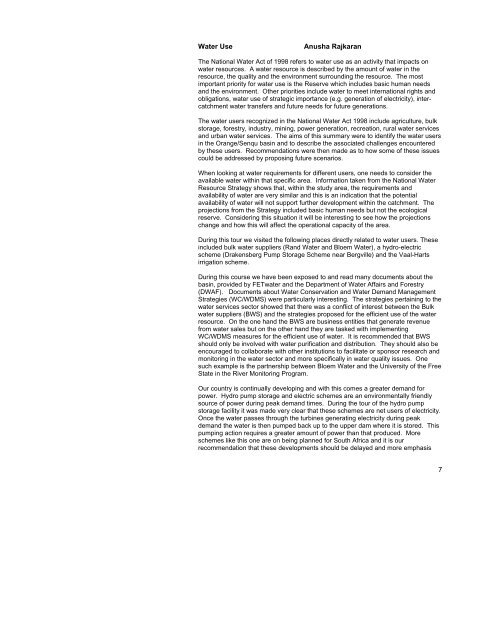An integrated assessment of socio-economic and ... - Unesco
An integrated assessment of socio-economic and ... - Unesco
An integrated assessment of socio-economic and ... - Unesco
Create successful ePaper yourself
Turn your PDF publications into a flip-book with our unique Google optimized e-Paper software.
Water Use <strong>An</strong>usha Rajkaran<br />
The National Water Act <strong>of</strong> 1998 refers to water use as an activity that impacts on<br />
water resources. A water resource is described by the amount <strong>of</strong> water in the<br />
resource, the quality <strong>and</strong> the environment surrounding the resource. The most<br />
important priority for water use is the Reserve which includes basic human needs<br />
<strong>and</strong> the environment. Other priorities include water to meet international rights <strong>and</strong><br />
obligations, water use <strong>of</strong> strategic importance (e.g. generation <strong>of</strong> electricity), intercatchment<br />
water transfers <strong>and</strong> future needs for future generations.<br />
The water users recognized in the National Water Act 1998 include agriculture, bulk<br />
storage, forestry, industry, mining, power generation, recreation, rural water services<br />
<strong>and</strong> urban water services. The aims <strong>of</strong> this summary were to identify the water users<br />
in the Orange/Senqu basin <strong>and</strong> to describe the associated challenges encountered<br />
by these users. Recommendations were then made as to how some <strong>of</strong> these issues<br />
could be addressed by proposing future scenarios.<br />
When looking at water requirements for different users, one needs to consider the<br />
available water within that specific area. Information taken from the National Water<br />
Resource Strategy shows that, within the study area, the requirements <strong>and</strong><br />
availability <strong>of</strong> water are very similar <strong>and</strong> this is an indication that the potential<br />
availability <strong>of</strong> water will not support further development within the catchment. The<br />
projections from the Strategy included basic human needs but not the ecological<br />
reserve. Considering this situation it will be interesting to see how the projections<br />
change <strong>and</strong> how this will affect the operational capacity <strong>of</strong> the area.<br />
During this tour we visited the following places directly related to water users. These<br />
included bulk water suppliers (R<strong>and</strong> Water <strong>and</strong> Bloem Water), a hydro-electric<br />
scheme (Drakensberg Pump Storage Scheme near Bergville) <strong>and</strong> the Vaal-Harts<br />
irrigation scheme.<br />
During this course we have been exposed to <strong>and</strong> read many documents about the<br />
basin, provided by FETwater <strong>and</strong> the Department <strong>of</strong> Water Affairs <strong>and</strong> Forestry<br />
(DWAF). Documents about Water Conservation <strong>and</strong> Water Dem<strong>and</strong> Management<br />
Strategies (WC/WDMS) were particularly interesting. The strategies pertaining to the<br />
water services sector showed that there was a conflict <strong>of</strong> interest between the Bulk<br />
water suppliers (BWS) <strong>and</strong> the strategies proposed for the efficient use <strong>of</strong> the water<br />
resource. On the one h<strong>and</strong> the BWS are business entities that generate revenue<br />
from water sales but on the other h<strong>and</strong> they are tasked with implementing<br />
WC/WDMS measures for the efficient use <strong>of</strong> water. It is recommended that BWS<br />
should only be involved with water purification <strong>and</strong> distribution. They should also be<br />
encouraged to collaborate with other institutions to facilitate or sponsor research <strong>and</strong><br />
monitoring in the water sector <strong>and</strong> more specifically in water quality issues. One<br />
such example is the partnership between Bloem Water <strong>and</strong> the University <strong>of</strong> the Free<br />
State in the River Monitoring Program.<br />
Our country is continually developing <strong>and</strong> with this comes a greater dem<strong>and</strong> for<br />
power. Hydro pump storage <strong>and</strong> electric schemes are an environmentally friendly<br />
source <strong>of</strong> power during peak dem<strong>and</strong> times. During the tour <strong>of</strong> the hydro pump<br />
storage facility it was made very clear that these schemes are net users <strong>of</strong> electricity.<br />
Once the water passes through the turbines generating electricity during peak<br />
dem<strong>and</strong> the water is then pumped back up to the upper dam where it is stored. This<br />
pumping action requires a greater amount <strong>of</strong> power than that produced. More<br />
schemes like this one are on being planned for South Africa <strong>and</strong> it is our<br />
recommendation that these developments should be delayed <strong>and</strong> more emphasis<br />
7
















